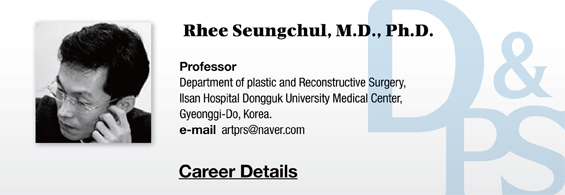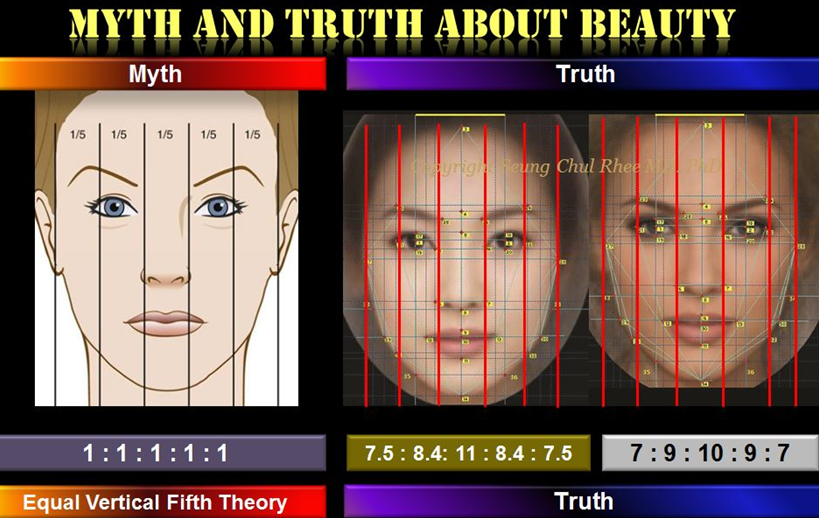
Although the commonly held preferences and ideals of physical beauty change over time, we tend to adhere to antiquated aesthetic standards or think it is not important to update them to better suit the modern demands. Some may believe that these antiquated theories or notions on an aesthetically ideal face may not seem relevant in clinical practice. However, I am confident that many aesthetic clinicians find my aesthetic analyses clinically relevant.
When programmed aesthetic procedures do not always produce fully satisfactory results despite pertinent cephalometric analysis of the facial bone and soft tissues before precise facial contour correction and even with successful consultation with an orthodontist in some cases, my analyses can serve as a clue toward resolving the problem. The discrepancy between ancient standards and modern ideals are bound to affect the field of aesthetic medicine.

Image3. Equal Vertical Fifth Theory.
As we have discussed above, traditional theories on facial proportions that were followed in plastic surgery were based on average faces or have roots in ancient art and sculpture. Therefore, they need to be reassessed in the modern light as they do differ from what is considered attractive today.
Aesthetic standards change over time and have particularly gone through drastic changes in the recent times. I am not claiming that my analysis of attractive faces should serve as the ultimate standard of of beauty. I only want to emphasize that we can no longer adhere to antiquated notions such as the golden ratio or the rule of fifth, etc. as mathematical references for all faces. We should evolve our notions of aesthetic standards to better suit today’s changing trends and the first step toward this goal would be reevaluating the old theories.
[Advertisement] PICOCARE - Manufacturer: WONTECH(www.wtlaser.com)
References
1. Rhee SC, Lee SH. (2010) Attractive composite faces of different races. Aesthetic Plast Surg. 34(6):800-1.
2. Rhee SC (2006) The average Korean attractive face. Aesthetic Plast Surg. 30(6):729-30.
3. Rhee SC, Woo KS, Kwon B (2012) Biometric study of eyelid shape and dimensions of different races with references to beauty. Aesthetic Plast Surg. 36(5):1236-45. doi: 10.1007/s00266-012-9937-7.
4. Little AC, Jones BC, Waitt C, Tiddeman BP, Feinberg DR, Perrett DI, Apicella CL, Marlowe FW (2008) Symmetry is related to sexual dimorphism in faces: data across culture and species. PLoS One 3(5):e2106
5. Dodgson NA (2004) Variation and extrema of human interpupillary distance. In: Woods AJ, Merritt JO, Benton SA, Bolas MT(eds), Stereoscopic displays and virtual reality systems, XIth proceedings of the SPIE, San Jose CA, 18–22 January 2004
6. Kim CJ, Ham KS (1988) A facial anthropometric study on the Korean youths. Arch Plast Surg 5:427
7. Barretto RL, Mathog RH (1999) Orbital measurement in black and white populations. Laryngoscope 109:1051–1054
8. Farkas LG, Hreczko TA, Kolar JC, Munro IR. Vertical and horizontal proportions of the face in young adult North American Caucasians: revision of neoclassical canons. Plast Reconstr Surg. 1985;75(3):328–38.
9. Sim RST, Smith JD, Chan ASY. Comparison of the aesthetic facial proportions of Southern Chinese and white women. Arch Facial Plast Surg. 2000;2(2):113–20.
10. Oak-Reon Park; Mi-Young Song. Anthropometric Studies on the Analysis of Women's Beautiful Face Korean journal of human ecology, 2005, 143.5.
11. Gao Y, Niddam J, Noel W, Hersant B, Meningaud JP (2016) Comparison of aesthetic facial criteria between Caucasian and East Asian female populations: An esthetic surgeon's perspective. Asian J Surg. pii: S1015-9584(16)30179-8. doi: 10.1016/j.asjsur.2016.07.007.
-To be continued




















